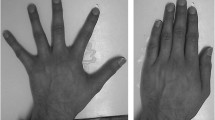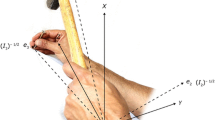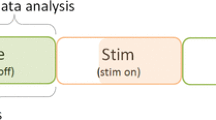Abstract
The purpose of the current work was to quantify the influence of posture-mediated skin deformation on trunk dorsum tactile perceptual sensitivity. Twelve young and healthy individuals were assessed while adopting three different spine postures (extension, neutral and flexion). Tactile sensitivity threshold tests (T10 and L4 vertebral levels) included measures of touch sensitivity, spatial acuity and stretch sensitivity. The results demonstrate that tactile sensitivity can differ due to changes in body posture. The skin of the trunk dorsum had increased thresholds for touch sensitivity, longitudinal spatial acuity and transverse stretch sensitivity in spine flexion. Furthermore, spine flexion also resulted in a reduced sensory threshold to stretching stimuli in the longitudinal direction. The opposite trends occurred when participants adopted spine extension. It is suggested that posture-mediated skin deformation generates changes in the amount of strain experienced by individual skin mechanoreceptors, and the relative spacing between mechanoreceptors. Furthermore, it is suggested that “pre-stretch” of the skin brings mechanoreceptors closer to their stretch activation thresholds, thereby increasing an individual’s sensitivity to skin stretch when in spine flexion.




Similar content being viewed by others
References
Barker, K. L., C. J. Elliot, C. M. Sackley, and J. C. T. Fairbank. Treatment of chronic back pain by sensory discrimination training. A phase I RCT of a novel device (FairMed) vs. TENS. BMC Musculoskelet. Disord. 9:97, 2008.
Baudry, S., S. Collignon, and J. Duchateau. Influence of age and posture on spinal and corticospinal excitability. Exp. Gerontol. 69:62–69, 2015.
Beaudette, S. M., K. J. Larson, D. J. Larson, and S. H. M. Brown. Low back skin sensitivity has minimal impact on active lumbar spine proprioception and stability on healthy adults. Exp. Brain Res. 234:2215–2226, 2016.
Beaudette, S. M., D. P. Zwambag, L. R. Bent, and S. H. M. Brown. Spine postural change elicits localized skin structural deformation of the trunk dorsum in vivo. J. Mech. Behav. Biomed. 67:31–39, 2017.
Bhushan, B. Nanotribological and nanomechanical properties of skin with and without cream treatment using atomic force microscopy and nanoindentation. J. Colloid. Interface Sci. 367:1–33, 2012.
Callaghan, J. P., and S. M. McGill. Intervertebral disc herniation: studies on a porcine model exposed to highly repetitive flexion/extension motion with compressive force. Clin. Biomech. 16:28–37, 2001.
Castro-Sánchez, A. M., I. C. Lara-Palomo, G. A. Matarán-Peñarrocha, M. Fernández-Sánchez, N. Sánchez-Labraca, and M. Arroyo-Morales. Kinesio taping reduces disability and pain slightly in chronic non-specific low back pain: a randomized trial. J. Physiother. 58(2):89–95, 2012.
Catley, M. J., A. Tabor, B. M. Wand, and G. L. Moseley. Assessing tactile acuity in rheumatology and musculoskeletal medicine – how reliable are two-point discrimination tests at the neck, hand, back and foot? Rheumatology 52:1454–1461, 2013.
Catley, M. J., N. E. O’Connell, C. Berryman, F. F. Ayhan, and G. L. Moseley. Is tactile acuity altered in people with chronic pain? A systematic review and meta-analysis. J. Pain 15(10):985–1000, 2014.
Cody, F. W., R. Idrees, D. X. Spilioti, and E. Poliakoff. Tactile spatial acuity is reduced by skin stretch at the human wrist. Neurosci. Lett. 484:71–75, 2010.
Collins, D. F., K. M. Refshauge, G. Todd, and S. C. Gandevia. Cutaneous receptors contribute to kinesthesia at the index finger, elbow, and knee. J. Neurophysiol. 94:1699–1706, 2005.
Dellon, A. L. Evaluation of sensibility. In: Evaluation of Sensibility and Re-education of Sensation in the Hand, edited by A. L. Dellon. Towson: The Dellon Institutes for Peripheral Nerve Surgery LLC, 2014, pp. 111–223.
Dellon, E. S., K. Keller, V. Mortz, and A. L. Dellon. The relationship between skin hardness, pressure perception and two-point discrimination in the fingertip. J. Hand Surg. 20B(1):44–48, 1995.
Dyck, P. J., P. C. O’Brien, J. L. Kosanke, D. A. Gillen, and J. L. Karnes. A 4, 2 and 1 stepping algorithm for quick and accurate estimation of cutaneous sensation threshold. Neurology 43:1508–1512, 1993.
Edin, B. B., and J. H. Abbs. Finger movement responses of cutaneous mechanoreceptors in the dorsal skin of the human hand. J. Neurophysiol. 65(3):657–670, 1991.
Flor, H., C. Braun, T. Elbert, and N. Birbaumer. Extensive reorganization of the primary somatosensory cortex in chronic back pain patients. Neurosci. Lett. 224:5–8, 1997.
Flor, H., C. Denke, M. Schaefer, and S. Grüsser. Effect of sensory discrimination training on cortical reorganization and phantom limb pain. Lancet 357:1763–1764, 2001.
Forster, B., C. Cavina-Pratesi, S. M. Aglioti, and G. Berlucchi. Redundant target effect and intersensory facilitation from visual-tactile interactions in simple reaction time. Exp. Brain Res. 143:480–487, 2002.
Gardner, E. P., and K. O. Johnson. Touch. In: Principles of Neural Science, edited by E. R. Kandel, J. H. Schwartz, T. M. Jessel, S. A. Siegelbaum, and A. J. Hudspeth. New York: McGraw Hill, 2013, pp. 498–529.
Geerligs, M. A literature review of the mechanical behavior of the stratum corneum, the living epidermis and the subcutaneous fat tissue. Technical Note PR-TN 2006/00450, Koninklijke Phillips Electronics N.V., 2006.
Godlove, J., E. O’Brien, and A. Batista. Comparing temporal aspects of visual, tactile and microstimulation feedback for motor control. J. Neural Eng. 11(14):046025, 2014.
Gutknecht, M., A. Mannig, A. Waldvogel, B. M. Wand, and H. Luomajoki. The effect of motor control and tactile acuity training on patients with non-specific low back pain and movement control impairment. J. Bodyw. Mov. Ther. 19:722–731, 2015.
Hagen, L., J. J. Hebert, J. Dekanich, and S. Koppenhaver. The effect of elastic therapeutic taping on back extensor muscle endurance in patients with low back pain: a randomized, controlled, crossover trial. J. Orthop. Sports Phys. Ther. 45(3):215–219, 2015.
Hudson, K. M., M. Condon, R. Ackerley, F. McGlone, H. Olausson, V. G. Macefield, and I. Birznieks. Effects of changing skin mechanics on the differential sensitivity to surface compliance by tactile afferents in the human finger pad. J. Neurophysiol. 114:2249–2257, 2015.
Johansson, R. S., and Å. B. Vallbo. Detection of tactile stimuli. Thresholds of afferent units related to psychophysical thresholds in the human hand. J. Physiol. 297:405–422, 1979.
Kalron, A., and S. Bar-Sela. A systematic review of the effectiveness of kinesio taping® - fact or fashion? Eur. J. Phys. Rehabil. Med. 49:699–709, 2013.
Kelle, B., R. Güzel, and H. Sakalli. The effect of kinesio taping application for acute non-specific low back pain: a randomized controlled clinical trial. Clin. Rehabil. 30(10):997–1003, 2016.
Kennedy, P. M., and J. T. Inglis. Distribution and behavior of glabrous cutaneous receptors in the human foot sole. J. Physiol. 538(3):995–1002, 2002.
Langer, K. On the anatomy and physiology of the skin: 1. The cleavability of the cutis. Br. J. Plast. Surg. 31:3–8, 1978.
Levesque, J. L., J. Dresler, E. Ribot-Ciscar, J. P. Roll, and C. Poelman. Changes in tactile spatial discrimination and cutaneous coding properties by skin hydration in the elderly. J. Investig. Dermatol. 115:454–458, 2000.
Lloyd, D., G. Findlay, N. Roberts, and T. Nurmikko. Differences in low back pain behavior are reflected in cerebral response to tactile stimulation of the lower back. Spine 33(12):1372–1377, 2008.
Luomajoki, H., and G. L. Moseley. Tactile acuity and lumbopelvic motor control in patients with back pain and healthy controls. Br. J. Sports Med. 45:437–440, 2011.
Macefield, V. G. Physiological characteristics of low-threshold mechanoreceptors in joints, muscle and skin in human subjects. Clin. Exp. Pharmacol. Physiol. 32:125–144, 2005.
Maiti, R., L.-C. Gerhardt, Z. S. Lee, R. A. Byers, D. Woods, J. A. Sanz-Herrera, S. E. Franklin, R. Lewis, S. J. Matcher, and M. J. Carré. In vivo measurement of skin surface strain and sub-surface layer deformation induced by natural tissue stretching. J. Mech. Behav. Biomed. 62:556–569, 2016.
Martin, B. J., B.-C. Lee, and K. H. Sienko. A cutaneous positioning system. Exp. Brain Res. 233:1237–1245, 2015.
Mildren, R. L., N. D. J. Strzalkowski, and L. R. Bent. Foot sole skin vibration perceptual thresholds are elevated in standing compared to sitting. Gait Posture 43:87–92, 2016.
Moseley, G. L. I can’t find it! Distorted body image and tactile dysfunction in patients with chronic back pain. Pain 140:239–243, 2008.
Moseley, G. L., N. M. Zalucki, and K. Wiech. Tactile discrimination, but not tactile stimulation alone, reduces chronic limb pain. Pain 137:600–608, 2008.
Ní Annaidh, A., K. Bruyére, M. Destrade, M. D. Gilchrist, and M. Otténio. Characterization of the anisotropic mechanical properties of excised human skin. J. Mech. Behav. Biomed. 5:139–148, 2012.
Nolan, M. F. Quantitative measures of cutaneous sensation: two-point discrimination values for the face and trunk. Phys. Ther. 65:181–185, 1985.
Otténio, M., D. Tran, A. Ní Annaidh, M. D. Gilchrist, and K. Bruyére. Strain rate and anisotropy effects on tensile fracture characteristics of human skin. J. Mech. Behav. Biomed. 41:241–250, 2015.
Peters, R. M., E. Hackerman, and D. Goldreich. Diminutive digits discern delicate details: fingertip size and sex differences in tactile spatial acuity. J. Neurosci. 29(50):15756–15761, 2009.
Rabey, M., H. Slater, P. O’Sullivan, D. Beales, and A. Smith. Somatosensory nociceptive characteristics differentiate subgroups in people with chronic low back pain: a cluster analysis. Pain 156:1874–1884, 2015.
Rigato, S., A. J. Bremner, L. Mason, A. Pickering, R. Davis, and J. van Velzen. The electrophysiological time course of somatosensory spatial remapping: vision of the hands modulates effects of posture on somatosensory evoked potentials. Eur. J. Neurosci. 38:2884–2892, 2013.
Scott, J. J., and R. Gray. A comparison of tactile, visual, and auditory warnings for rear-end collision prevention in simulated driving. Hum. Factors 50(2):264–275, 2008.
Semmes, J., S. Weinstein, L. Ghent, and H. Teuber. Somatosensory Changes after Penetrating Brain Wounds in Man. Cambridge, MA: Harvard University Press, 1960.
Strzalkowski, N. D. J., R. L. Mildren, and L. R. Bent. Thresholds of cutaneous afferents related to perceptual threshold across the human foot sole. J. Neurophysiol. 114:2144–2151, 2015.
Strzalkowski, N. D. J., J. J. Triano, C. K. Lam, C. A. Tempelton, and L. R. Bent. Thresholds of skin sensitivity are partially influenced by mechanical properties of the skin on the foot sole. Physiol. Rep. 3(6):e12425, 2015.
Wälti, P., J. Kool, and H. Luomajoki. Short-term effect of pain and function of neurophysiological education and sensorimotor retraining compared to usual physiotherapy in patients with chronic or recurrent non-specific low back pain, a pilot randomized controlled trial. BMC Musculoskelet. Disord. 16:83, 2015.
Wand, B. M., F. Di Pietro, P. George, and N. E. O’Connell. Tactile thresholds are preserved yet complex sensory function is impaired over the lumbar spine of chronic non-specific low back pain patients: a preliminary investigation. Physiotherapy 96:317–323, 2010.
Wu, K. S., W. W. van Osdol, and R. H. Dauskardt. Mechanical properties of human stratum corneum: effects of temperature, hydration and chemical treatment. Biomaterials 27:785–795, 2006.
Acknowledgments
This work was funded by the Natural Sciences and Engineering Research Council (NSERC) of Canada (Grant No. 402407-2013). The authors wish to thank Dr. Diane Gregory for the loan of equipment used within the current project.
Conflict of interest
No conflicts of interest, financial or otherwise, are declared by the authors.
Author information
Authors and Affiliations
Corresponding author
Additional information
Associate Editor Peter E. McHugh oversaw the review of this article.
Rights and permissions
About this article
Cite this article
Beaudette, S.M., Smith, S.G.V.S., Bent, L.R. et al. Spine Posture Influences Tactile Perceptual Sensitivity of the Trunk Dorsum. Ann Biomed Eng 45, 2804–2812 (2017). https://doi.org/10.1007/s10439-017-1924-3
Received:
Accepted:
Published:
Issue Date:
DOI: https://doi.org/10.1007/s10439-017-1924-3




